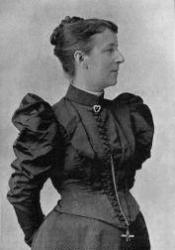Planning worship?
Check out our sister site, ZeteoSearch.org,
for 20+ additional resources related to your search.
- |
User Links
Person Results
A. L. Peace

1844 - 1912 Person Name: Dr. A. L. Peace, 1844-1912 Composer of "LUX BEATA" in Methodist Hymn and Tune Book Albert Lister Peace DMus United Kingdom 1844-1912. Born at Huddersfield, Yorkshire, England, son of a warehouseman and woolstapler, he was extremely gifted as a musician, largely self-taught, playing the organ at Holmfirth Parish Church near Huddersfield at age nine. He married Margaret Martin Steel Gilchrist, and they had three children: Lister, Archibald, and Margaret. In 1865 he was appointed organist of Trinity Congregational Church in Glasgow, Scotland. He obtained his doctorate degree from the University of Oxford in 1875. He became organist at Glasgow Cathedral in 1879. In 1897 he succeeded William Best as organist at St George’s Hall, Liverpool. In later years he was in much demand to play the organ in recitals. He did so at Canterbury Cathedral (1886), Victoria Hall, Hanley, Stoke-on-Trent (1888), and Newcastle Cathedral (1891). He composed orchestrations, sonatas, cantatas, and concert and church service anthems. He was an arranger, author, and editor. He died at Blundelsands, Liverpool, England.
John Perry
A. L. Peace
W. F. Stewart
Composer of "[Light of the world, faint were our weary feet]" in Celestial Songs
W. F. Stewart
Charles H. Purday
1799 - 1885 Composer of "SANDON" in The Cyber Hymnal Charles H. Purday (1799-1885) A publisher, composer, lecturer, and writer, Purday had a special interest in church music. He published Crown Court Psalmody (1854), Church and Home Metrical Psalter and Hymnal (1860), which included SANDON, and, with Frances Havergal, Songs of Peace and Joy (1879). A precentor in the Scottish Church in Crown Court, London, Purday sang at the coronation of Queen Victoria. In the publishing field he is known as a strong proponent of better copyright laws to protect the works of authors and publishers.
Bert Polman
Charles H. Purday
Laura Ormiston Chant

1848 - 1923 Person Name: Mrs. Ormiston Chant, 1848 Author of "Light of the world, faint were our weary feet" in Methodist Hymn and Tune Book Chant, Laura Ormiston, née Dibdin, daughter of F. W. Dibdin, O.E., was bom at Woolastone, Gloucestershire, in 1848, was for some time Sister of the Sophia Wards of the London Hospital, and married to Thomas Chant, M.R.C.S., of Bridgewater, in 1877. Of Mrs. Chant's hymns, these are in common use:—
1. Beyond the far horizon. [Heaven.] Written at the request of Stopford A. Brooke for his Christian Hymns, 1891. It is also printed as a leaflet in 5 stanzas of 8 lines.
2. Light of the world, faint were our weary feet. [Christ the Light of the World.] Written in June, 1901, at the request of the Rev. S. Collier, Superintendent of the Central Wesleyan Mission in Manchester. As the hymn is regarded by many as an imitation of Cardinal Newman's "Lead, kindly light," &c, Mrs. Chant's account of its origin is worthy of attention:—
Mr. Collier "said how amazingly fond the rescued men were of the tune 'Sandon,' but that 'Lead, kindly light,' though so beautiful, was not an adequate expression of their feelings, and would I try and write something as tender, but gladder than Newman's lovely hymn. I did my best to express myself, and so gave what was wanted" The hymn was first printed as a broadsheet, and then passed into The Methodist Hymn Book, 1904, and other collections.
3. Silence, 0 earth, and listen to the song. [Spring.] This hymn is of more than usual excellence, and is worthy of attention. It is printed as a broadsheet, and may be had at Albemarle House, E. Twickenham.
--John Julian, Dictionary of Hymnology, New Supplement (1907)
Laura Ormiston Chant
James T. Lightwood

1856 - 1944 Person Name: J. T. Lightwood, 1856-1944 Composer of "BARTON" in The Methodist Hymn-Book with Tunes Born: 1856, Leeds, England.
Died: 1944, Lytham, Lancashire, England.
Son of Wesleyan minister Edward Lightwood, James was born and baptized while his father was on the Leeds Brunswick Circuit. He attended Kingswood School (1866-72), earned a BA from London University, and became Headmaster of Pembroke House, a private school in Lytham. He went on to serve for three years as a member of the Board of Improvement Commissioners in Lytham, on the Lytham Council for six years, and as Chairman of the Streets Committee for four years. His resolution to bring gas into Fairhaven was eventually carried by one vote. Apart from music, his other great love was cycling. He began cycling in 1874 on a "boneshaker." By 1885, he was a member of the Cyclists Touring Club (CTC), and soon gained prominence. He was Chief Consul for Lancashire, and a member of the Council of the CTC from 1887. Honorary life membership came in 1907 in recognition of his services to the club, and in particular with publication of the club’s route books and other writings.
Music was his great love, though, and hymnody in particular. He was an accomplished organist, and after two years as deputy organist at the Drive Wesleyan Church, St. Annes, he was appointed Honorary Organist and Choirmaster in 1894. When the pressure of work due to his appointment as editor of the new Methodist publication The Choir and organizing the newly formed Music Department of the Methodist Publishing House, the trustees at Drive Church made him a grant of £20 to assist him in his research in hymnology. While advising Methodism on musical matters, he found the unique 1761 Snetzler organ for the New Room at Bristol.
Lightwood’s works include:
Hymn Tunes and Their Story (London: Charles H. Kelly, 1905)
Charles Dickens and Music, 1912
Samuel Wesley, Musician: The Story of His Life
Cyclists’ Touring Club: The Romance of 50 Years Cycling, 1928
The Music of the Methodist Hymn-Book (London: The Epworth Press, 1935)
http://www.hymntime.com/tch/bio/l/i/g/lightwood_jt.htm
James T. Lightwood


 My Starred Hymns
My Starred Hymns


